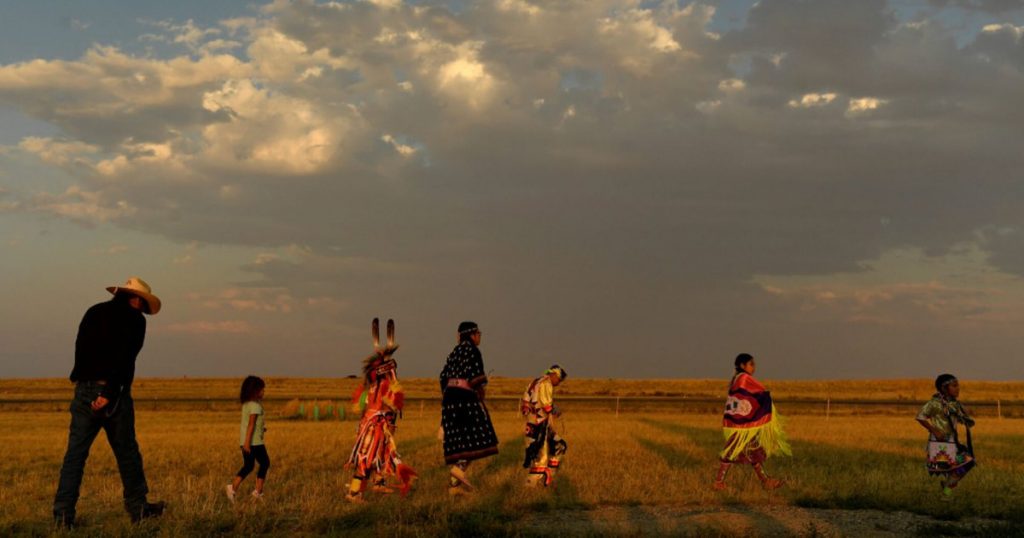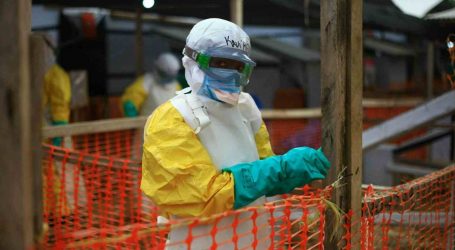This Tribe Will Gladly Accept Clean Energy Funding, Even If Wyoming Won’t
Northern Arapaho host a local powwow on the eve of a solar eclipse in Riverton, Wyoming.Helen H. Richardson/Getty Images
This story was originally published by Inside Climate News and is reproduced here as part of the Climate Desk collaboration.
When Wyoming governor Mark Gordon told the Environmental Protection Agency in 2023 that the state would not be applying for federal grant money to reduce pollution and greenhouse gases, he left most communities in the state without access to potentially transformative funds to upgrade infrastructure, reduce pollution, and bring down costs for local governments.
But in the nation’s most sparsely populated state, two cities and the Northern Arapaho and Eastern Shoshone tribes could qualify on their own for Climate Pollution Reduction Grants (CPRG) from the $4.6 billion made available to states, cities, tribes and territories under the Inflation Reduction Act to reduce greenhouse gas emissions and air pollution. On April 1, Cheyenne, Wyoming’s capital, submitted its application for more than $99 million to cover most of the cost of building two solar farms and making upgrades to both of its wastewater treatment plants.
Northern Arapaho members host a local powwow on the eve of a solar eclipse in Riverton, Wyoming.
Helen H. Richardson/ Getty Images
The Northern Arapaho, which is qualified to apply for the $4.6 billion in general funding, met the EPA’s deadline to do so earlier this month. The tribe is also eligible for $300 million in EPA tribal funding, for which it is finalizing an application ahead of a May 1 deadline. The tribe hopes federal money will fund a solar-powered microgrid on its reservation, enable weatherization and energy efficiency upgrades to residents’ homes, and help convert the tribe’s vehicle fleet to electric and hybrid cars.
Officials from the Northern Arapaho Tribe and city of Cheyenne called the grant money potentially transformational. “This money would really, truly help big time,” said Dean Goggles, environmental director for the tribe’s natural resources office.
Wyoming faces a series of climate change-related threats to its environment, people, plants, and animals. Temperatures in the state have already risen 2.5 degrees Fahrenheit since the onset of the 20th century, according to the National Oceanic and Atmospheric Administration. As temperatures rise, the rate and severity of droughts and wildfires are projected to increase and the severity of storms across the state is expected to rise, too. With “unprecedented warming” expected to continue, “communities in Wyoming will continue to experience higher average temperatures, warmer winters, decreased snowfall, stronger storm precipitation events and increased risk of drought and wildfires,” said an EPA spokesperson.
The Northern Arapaho will likely prioritize projects that will increase the tribe’s energy independence and the community’s resilience to severe weather events. Tribal planners began working on the community’s application last fall, and identified the building and transportation sectors as the largest sources of climate-warming emissions the tribe could address. “There’s a lot of interest in solar here,” said Steve Babits, an environmental scientist with the Northern Arapaho Natural Resource Office. “People are pretty interested in being more self-sufficient with the utilities.”
In its Priority Climate Action Plan (PCAP), a planning document the Northern Arapaho submitted to the EPA last month in order to qualify for general funding, the tribe laid out plans to apply for funds to build a community‐scale solar farm with battery storage on the Wind River Reservation. Such a project could reduce the tribe’s emissions and “provide affordable, reliable power” to the community, the tribe wrote. As Goggles and Babits met with tribal government groups about the PCAP, they said the idea proved popular. “Everyone is faced with high utility bills,” Babits said. “What we’re looking at is something that would be off the grid and generate its own power.”
Weatherizing housing on the reservation is another of the tribe’s top priorities. By constructing high-efficiency buildings using electrical heating systems, putting them close together and retrofitting current buildings with better insulation, the tribe can minimize driving and create homes that “more easily ‘ride out’ power failures during inclement weather by minimizing heat energy losses to the exterior,” it said. This would help solve “major public health issues on the reservation” during Wyoming’s biting winters.
The Northern Arapaho also signaled they might seek funds to replace the tribe’s fleet of diesel and gas-powered vehicles with electric and hybrid ones. Babits said funding for any of these plans would help the community create jobs. “The reservation is an underserved community, it could really benefit from that,” he said.
About 300 miles to the southeast of the Wind River reservation, Renee Smith had been working diligently on Cheyenne’s PCAP and CPRG. “We’ve been working toward this for a year. We just weren’t anticipating being the lead,” she said, referencing Gordon’s decision to remove the state from funding consideration.
Like the Northern Arapaho, Smith sees these funds as an opportunity to expand Cheyenne’s renewable energy portfolio. The city is working with Black Hills Energy, a local utility company, to install solar panels on city-owned cattle grazing lands, the municipality’s closed landfill, and both its wastewater treatment plants. (In Wyoming, cities cannot own and provide their own energy.) Together, these projects could add more than 96,000 megawatts to Cheyenne’s grid annually, helping the city meet its growing energy demand as more data center companies flock to the area, Smith said.
Pairing solar panels with cattle grazing, a burgeoning practice known as agrivoltaics, could be particularly transformative for the city. Cheyenne makes money by leasing land for grazing, and leasing that same land for solar development to a utility like Black Hills Energy is a way for the city to do some “double dipping,” Smith said.
“Cheyenne would become a national leader” if the city received money for this idea, Smith said. “No project in America would come close to the size and scale of this proposed project.”
Reusing the city’s old landfill as a solar farm would help power low-income residents’ homes, Smith said, and the goal would be to one day create a community solar site run by Black Hills. Installing solar panels at its Crow Creek and Dry Creek wastewater treatment plants would allow Cheyenne to power municipal infrastructure with cheaper energy, which would free up tax dollars “to fund quality of life projects” like outdoor and indoor recreation facilities Smith said. “We feel like this is just a once in a lifetime opportunity.”
In its CPRG application, the city also included plans to capture and sell methane collected from Dry Creek wastewater treatment plant to local utilities that can burn it as natural gas.
Any of these projects would develop employment opportunities in Cheyenne. Solar installation creates jobs “on the front end,” Smith said. As the panels are being set up, Cheyenne would train a workforce to “make sure we have enough qualified people to manage these [panels] and maintain them,” she said.
Absent federal funding, Cheyenne would be hard pressed to find ways to get these projects off the ground. Wyoming offers Energy Matching Funds, money from state coffers awarded by the Wyoming Energy Authority to projects that meet an array of energy criteria—most of which are focused on preserving the extraction and use of fossil fuels in a clean energy economy.
Cheyenne’s goal is to win as much grant money as it can from the federal competition, but “it would be great if the state could support this. Even in this small way,” Smith said.
States and cities that have applied for CPRG funds will compete based on grant proposal size. It is not yet clear how many other states or cities joined Cheyenne in applying for CPRG funding between $50 million to $99 million, but the EPA plans to award anywhere from six to 12 grants in that range, according to an EPA announcement in January.
If both the Northern Arapaho’s applications are deemed suitable for funding, the EPA would award the tribe only one grant.
With only two applicants from Wyoming, and Gordon electing to keep the state on the sidelines, grant planners from the Northern Arapaho and Cheyenne said they are aware that the rest of the state may be keeping tabs on how their applications turn out should the two communities receive funding. “Hopefully we can be a leader on this in the state and be a good example for everyone,” Babits said.
“It’s really exciting that we get to apply for these funds—and it’s even more exciting if we can move ahead,” Goggles added. “I’m anxious for it.”





